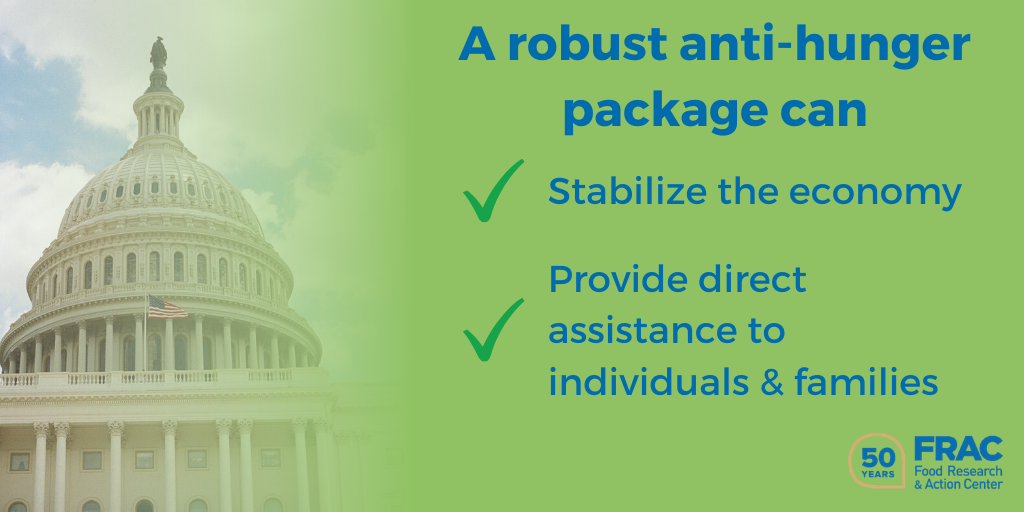
Food insecurity spikes to unprecedented level
The number of U.S. households suffering from food insecurity has nearly doubled since the onset of the COVID-19 pandemic in March, and food insecurity among children has more than quadrupled.
Those sobering conclusions are among the findings of a panel of experts who shared their research on a webinar this week sponsored by The Hamilton Project at the Brookings Institute, the Urban Institute, and Share Our Strength.
The webinar, titled, “The Impact of COVID-19 on Food Insecurity,” focused on three reports that contain the latest research into the level of food insecurity: “The COVID-19 Crisis Has Already Left Too Many Children Hungry in America,” by The Hamilton Project; “Many Families Are Struggling to Put Food on the Table. We Must Do More,” by the Urban Institute; and the Covid Impact Survey, by the Data Foundation.
Researchers agreed that vast racial inequities accompany the issue of food insecurity. For example, they reported that 37.5 percent of African American households with children reported food insecurity in the previous month, as did 40 percent of Latinx households with children – and that number rises to nearly 44 percent if the household contains a noncitizen. (By contrast, among non-Hispanic white adults with children, 17.6 percent reported food insecurity in the previous month.)

In March, food insecurity among children has more than quadrupled.
What researchers could not quantify is how much worse food insecurity is today compared with late April, which is when some of the data contained in the three reports was gathered. But they agree that food insecurity appears to already be worse than at any time during the Great Recession, and that the situation is rapidly deteriorating.
“We know now that food insecurity has spiked to an unprecedented level,” said Lauren Bauer, Economic Studies Fellow with The Hamilton Project. She reported that among mothers with children 12 years-old or younger, 17.4 percent said in the last week of April that at least sometimes, their children did not have enough to eat.
“It is almost unimaginable that in a few short months, we could see all of the progress we have made to end childhood hunger eradicated,” said Lisa Davis, Senior Vice President of Share Our Strength’s No Kid Hungry Campaign.
(Note: The Census Bureau’s Household Pulse survey has weekly findings about food scarcity in households with children. The questions asked in this survey are not directly comparable to the food security questions described above. They do not ask about households with children younger than 12; but they do get at a harsh level of deprivation in asking whether the people in the household sometimes or often did not have enough to eat during the past 7 days. For the week ending May 26, this survey found that one in five people in households where someone was not working because they were home caring for a child sometimes or often did not have enough to eat in the past 7 days.)
Davis emphasized that charity alone cannot make up the emerging food deficit – the federal government must play a robust role, and that role has to include increases in access to SNAP as well as increases in SNAP benefits. And she mentioned the impact that food insecurity has on children’s physical and cognitive well-being and development. “We cannot afford to get this wrong,” she said. We have got to get this right. The consequences will be with us for a lifetime for these kids.”

Congress needs to act NOW.
Elaine Waxman, Senior Fellow for the Urban Institute’s Income and Benefits Policy Center, has further laid out what is at stake, including poor physical and mental health outcomes.
“Research shows that children living in food-insecure households are at greater odds of fair or poor health, are more likely to be hospitalized in early childhood, may experience behavioral issues that interfere with schooling, and are at higher risk of certain chronic diseases, such as asthma,” she writes. “Among adolescents, food insecurity is associated with depression and suicidal ideation. There is an urgent need to ensure children and youth, regardless of income, race and ethnicity, or their family’s citizenship status, are not going without the food they need to thrive, learn, and grow.”
One of the challenges in fighting food insecurity, said Shane Garver, Senior Director for Rural Education, Save the Children US, is that it in itself is based on geographic inequities – people living in the South and in rural counties are often more likely to be in food-insecure households.
“Ninety percent of counties with high levels of food insecurity are rural,” Garver said. “If you’re living in a minority-majority county that is rural and poor, your child is three times as likely to be food insecure.”
So what can be done? If you represent an organization that opposes food insecurity, there is one thing you can do right now. Your group, be it state-based or national, can sign on to a letter urging the Senate and the Trump Administration to immediately boost SNAP benefits and invest in other important nutrition assistance programs.
The sign-on deadline is close of business, Wednesday, June 10.

